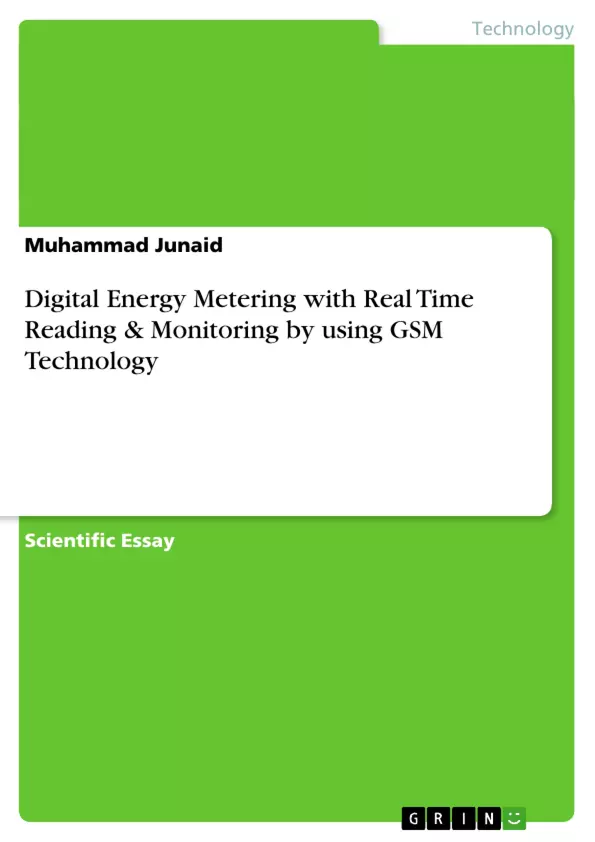Awareness on Power consumption is becoming vital these days. The proposed system is made up of postpaid billing system which uses GSM (Global System for Mobile Communication) to provide effective and efficient power meter reading, usage notification and distribution through wireless communication. The postpaid meter is important in making the consumer having sense about his/her energy consumption which is important in eliminating the difficulties facing the electrical utility employee in getting the reading of the conventional electromechanical meter and eliminating any error incurred in bills issuing. The designed digital meter consists of GSM module, a microcontroller, a digital meter & a wireless gateway. This proposed prototype of energy metering system comprises of two main parts; clients and server. A GSM module is used to read the ID of the SIM (Subscriber Identification Module) card. The server is located in the local substation which receives the SIM ID from clients and sends ID’s information back to the client after checking and/or updating the database. Moreover the system also display the amount of energy consumed on the LCD (Liquid Crystal Display).
The aim of the Research Project is to develop a system which uses microcontroller as a central part to provide postpaid services, and it uses GSM to update the WAPDA (Water and Power Development Authority Pakistan) about the unit consumed with time and date. So that consumer will be aware of their usage and for provider’s error occur and resources use can be reduced.
Inhaltsverzeichnis (Table of Contents)
- Abstract
- Key Words
- Introduction
- Physical Modelling & Hardware Implementation Process
- Block Diagram
- Circuit Diagram
- Hardware Implementation
- Future Work & Conclusion
- Recommendations
Zielsetzung und Themenschwerpunkte (Objectives and Key Themes)
This research project aims to develop a digital energy metering system that utilizes a microcontroller and GSM technology to provide postpaid services for electricity consumption. The system aims to enable real-time monitoring of energy usage, facilitate accurate billing, and improve the efficiency of energy distribution.
- Real-time energy monitoring and billing
- Improved accuracy and efficiency of energy distribution
- Reduced costs and increased profits for energy companies
- Enhanced consumer awareness of energy consumption
- Development of a microcontroller-based energy metering system
Zusammenfassung der Kapitel (Chapter Summaries)
- Abstract: This section introduces the concept of a postpaid billing system utilizing GSM technology for real-time energy metering, usage notification, and distribution. It emphasizes the importance of consumer awareness regarding energy consumption and highlights the system's potential to address challenges faced by electrical utility employees in traditional meter reading.
- Introduction: This section provides an overview of energy meters and their importance in studying energy demand. It highlights the need for cost-effective and efficient energy metering solutions for domestic applications. The section introduces the Digital Energy Meter as a solution, emphasizing its user-friendliness and capabilities in data collection.
- Physical Modelling & Hardware Implementation Process: This section delves into the hardware implementation of the digital energy metering system. It covers the block diagram, circuit diagram, and hardware components. The block diagram provides a high-level overview of the system's components and their interactions. The circuit diagram illustrates the connections between the components, including the microcontroller, GSM module, LCD, and other essential hardware elements. The hardware implementation section describes the physical construction of the system and the functions of each component.
Schlüsselwörter (Keywords)
This research project centers around the development of a digital energy metering system incorporating GSM technology. Key terms and concepts include energy metering, microcontroller, GSM, real-time monitoring, postpaid billing, energy consumption, WAPDA, CT (Current Transformer), PT (Potential Transformer), RTC (Real Time Clock), LCD (Liquid Crystal Display), and substation.
- Citation du texte
- Muhammad Junaid (Auteur), 2015, Digital Energy Metering with Real Time Reading & Monitoring by using GSM Technology, Munich, GRIN Verlag, https://www.grin.com/document/289192



